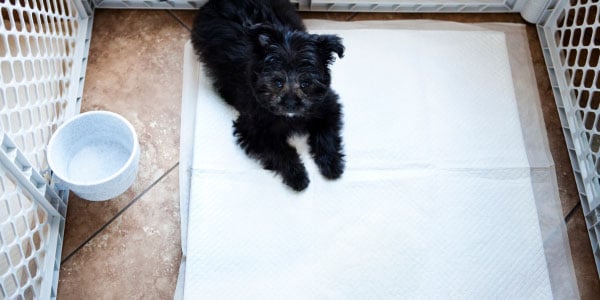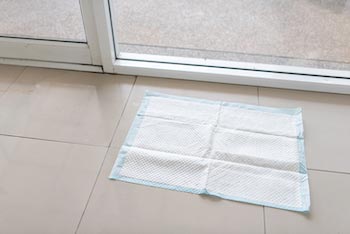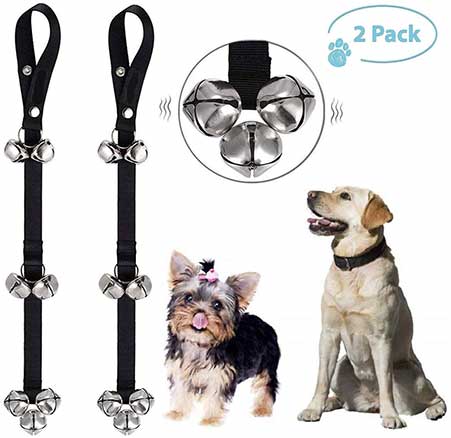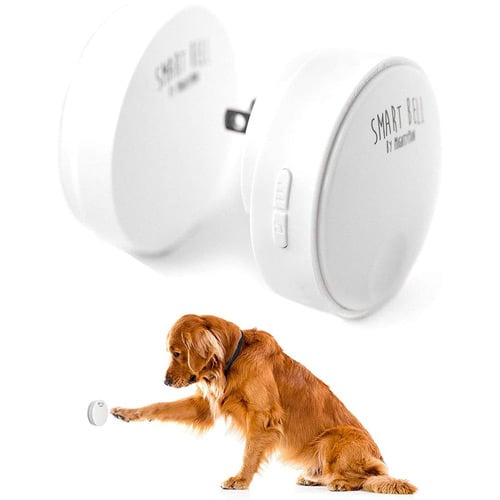
Has your puppy decided that their potty pads are best used as a bed? Or consider their indoor grass patch their new favorite chew toy to shred?
It might be time for your pup to transition away from using pee pads altogether.
Or perhaps you've relocated from an apartment to a home with a yard, and want to take advantage of using the outside as your dog's only potty spot.
If you're ready to get your puppy or dog to stop using pee pads, you'll want to go about it the right way! When done too quickly, it can confuse your dog and result in potty accidents.
Avoid just removing the pee pad or indoor grass patch altogether — that's asking for your dog to find an alternative "pad" somewhere else in your home (like your bathroom mat or hallway rug).
Read on for tips and tricks for teaching a dog who uses pee pads to only go potty outside.
Teaching a Pee Pad Trained Dog to Potty Outside
 Move Your Dog's Pad Closer to the Door in Small Steps
Move Your Dog's Pad Closer to the Door in Small Steps
Every day, move your dog's pee pad a foot or two closer to the door that leads outside. Eventually, it will be placed right by the door that leads outside.
Once your dog has done well with their new location, set the pad outside, right by the door. This step requires that you watch for when your dog goes to the door, so you can open it and give them a potty break on their pad outside.
After they've gotten comfortable using the pad outside, you can start to make the pad smaller. For dogs that use pee pads with built-in attractants, consider using potty attractant spray in their new outdoor potty area.
Reduce the Number of Potty Pads in Your Home
If your dog has several pads throughout your home, you'll want to wean them off multiple potty spots, so they are only going to one pee pad closer to the door that leads outside. You can do this much the same way you've been moving the main pad closer to the door. Start moving extra pads closer to the main pad in small increments over time. Then, when you've reached the same room, take away the extra pad altogether.
If you have a pee pad on each level of your multi-story house, it's often easier to simply block off your dog's access to the upstairs or downstairs pee pad areas using a baby gate or by closing doors.
Take Your Dog Out for Frequent Outside Potty Breaks
Be proactive! Give your dog plenty of outdoor potty breaks so you can then reward them for going in their new potty spot. The scent of previous eliminations in the outdoor area will help them associate it with where they should do their business.
PRO TIP: During the beginning steps of moving the pee pad closer to the door, when you see your dog go to their pad, take them outside instead. This will help speed up the transition process.
Reward for Going Potty Outside!
Each and every time your dog goes to the bathroom outside, reward them generously! A treat and praise after they've finished up is teaching them that it's way more rewarding to go potty outside than anywhere else. This step is crucial for transitioning away from indoor potty pads.
Watch for Signs Your Dog Needs to Go to the Bathroom
Carefully watching your dog during pee pad transition training is crucial for success, especially after you've placed the pad outside. Any time your dog goes to their pee pad while it's inside, take them outside instead so you can reward it. When you're unable to watch them closely, place them in their crate or playpen to help prevent accidents, and encourage them to hold it longer.
Signs that mean your dog might need to go potty:
- Sniffing the floor
- Seeking out a hiding spot or somewhere out of the way
- Pacing or circling
- Going to the door
- Pawing at the door or you
- Whining or barking
- Licking their groin or rear-end area
Consider Teaching Your Dog to Use Doorbells
Teaching your dog to use a doorbell or buzzer is a great way to stay ahead of any accidents. Once a dog has learned that ringing the bell means the door opens, it's easier for them to let us know that they want to go potty. However, using potty bells only works if you've been consistent in rewarding their outdoor house training! Otherwise, they don't know they're supposed to go potty outside, so why ring the bell to open the door?
After you've moved their potty pad outside and they've learned the new location, you can introduce the bells. You can do this in a couple of ways. Some owners teach their dog first to target the bells before pairing them with the door opening. Others hang up the bells or put the buzzer by the door and add ringing them into the potty break routine. Any time you're on your way outside, encourage your dog to hit the bell or button and reward with the door immediately opening and lots of praise!
Watch Preventive Vet puppy Finnegan show off his potty doorbell skills in this video:
PRO TIP: If you're using a buzzer like the one shown in the video above, make sure the button is easily visible for your puppy to see and then target. We placed one of these blue felt stickers on Finnegan's buzzer (dogs can see the colors blue and yellow better than others) so he knew where to push with his nose.
Transitioning a dog that's been potty pad trained to only go outside takes time — consistency and patience are the keys to success in this process. You're teaching your dog a new habit and breaking an old one at the same time, so don't get discouraged!
We'd love to hear your experience in transitioning your puppy or dog away from indoor potty pads. Let us know what's worked for you in the comments!
Related Resources
DOWNLOAD: Puppy Potty Log – helps with keeping track of accidents and potty schedule
Stop potty accidents and get help with house training in our Puppy Essentials: Potty Training Workshop
Includes self-paced training lessons, downloadable resources, video demonstrations, and more – all for only $9.






